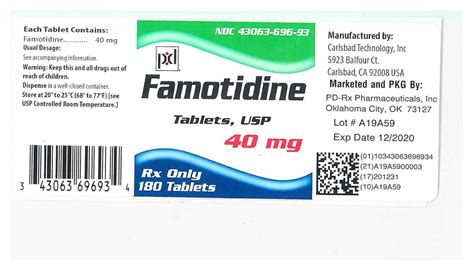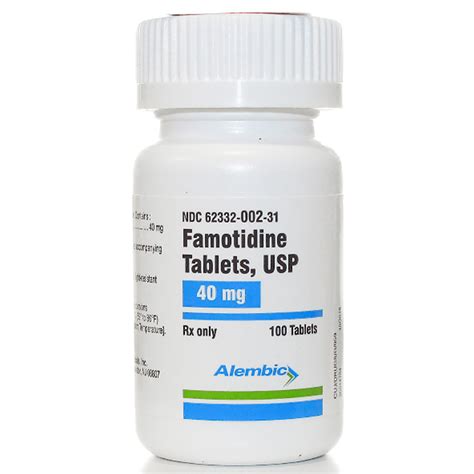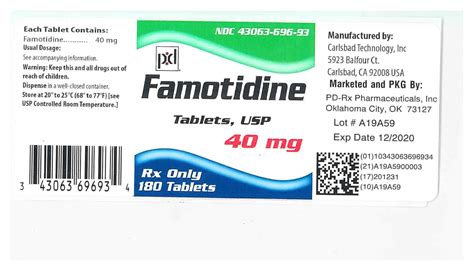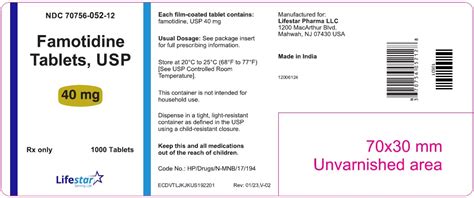Famotidine, commonly known by its brand name Pepcid, is a medication that has been widely used for several decades to treat various conditions related to the stomach and gastrointestinal tract. It belongs to a class of drugs known as histamine-2 (H2) blockers, which work by reducing the amount of acid produced in the stomach. The 40mg dosage of famotidine is one of the most commonly prescribed strengths for this medication. Here, we'll delve into the 5 primary uses of famotidine 40mg, exploring its applications, benefits, and how it works to alleviate symptoms.
The importance of managing stomach acid cannot be overstated, as excessive acid production can lead to discomfort, pain, and even long-term damage to the esophagus and stomach lining. Conditions such as gastroesophageal reflux disease (GERD), peptic ulcers, and Zollinger-Ellison syndrome are just a few examples where the regulation of stomach acid is crucial. Famotidine 40mg has been a cornerstone in the treatment of these and other related conditions, offering relief to millions of people worldwide.
Famotidine's mechanism of action involves blocking histamine receptors in the stomach, which are responsible for stimulating the secretion of gastric acid. By inhibiting these receptors, famotidine reduces acid production, thereby alleviating symptoms associated with excessive stomach acid. This makes it an effective treatment for a range of gastrointestinal issues, from mild heartburn to more severe conditions like ulcers. The effectiveness of famotidine 40mg in treating these conditions has been well-documented in medical literature, showcasing its value as a first-line treatment option.
Introduction to Famotidine 40mg
Famotidine 40mg is available in various forms, including tablets and oral suspensions, making it accessible to a wide range of patients. Its ease of use, coupled with a relatively low risk of side effects, has contributed to its popularity among both healthcare providers and patients. Understanding the uses of famotidine 40mg requires a look into the conditions it treats and how it integrates into treatment plans for these conditions.
Uses of Famotidine 40mg
The primary uses of famotidine 40mg can be categorized based on the conditions it is designed to treat. These include:
- **Gastroesophageal Reflux Disease (GERD):** Characterized by the backflow of stomach acid into the esophagus, leading to symptoms like heartburn and regurgitation.
- **Peptic Ulcers:** Sores that develop on the inside lining of the stomach and the upper portion of the small intestine, often caused by infection with Helicobacter pylori bacteria or long-term use of anti-inflammatory drugs.
- **Zollinger-Ellison Syndrome:** A rare disorder that causes the stomach to produce too much acid, leading to severe ulcers.
- **Heartburn and Acid Indigestion:** Common conditions where stomach acid flows back into the esophagus, causing discomfort and burning sensations.
- **Prevention of Aspirin and NSAID-Induced Ulcers:** For patients at risk of developing ulcers due to the use of aspirin or nonsteroidal anti-inflammatory drugs (NSAIDs).
How Famotidine 40mg Works
Famotidine works by competitively inhibiting the action of histamine at the H2 receptor sites in the gastric parietal cells. This inhibition results in a reduction of gastric acid secretion, which in turn helps to alleviate symptoms and facilitate the healing of ulcers and other lesions in the gastrointestinal tract. The onset of action for famotidine is relatively quick, with peak effects observed within one to three hours after administration, making it an effective option for both short-term relief and long-term management of acid-related disorders.
Benefits of Famotidine 40mg
The benefits of using famotidine 40mg include its efficacy in reducing stomach acid production, its relatively low cost compared to other medications like proton pump inhibitors (PPIs), and its safety profile, which makes it suitable for a wide range of patients, including the elderly and those with certain comorbid conditions. Additionally, famotidine 40mg is available over-the-counter (OTC) in many countries, allowing for easy access without the need for a prescription for occasional use.
Steps to Take Famotidine 40mg
To take famotidine 40mg effectively, patients should follow these steps:
- Take the medication with a full glass of water.
- For best results, take it at bedtime or as directed by a healthcare provider.
- Do not crush or chew the tablets; swallow them whole.
- If using the oral suspension, shake the bottle well before each use.
Practical Examples and Statistical Data
Studies have shown that famotidine 40mg is effective in healing peptic ulcers, with healing rates comparable to those of more potent acid-suppressing drugs in some cases. For instance, a clinical trial might demonstrate that after eight weeks of treatment with famotidine 40mg, approximately 80% of patients with duodenal ulcers achieve complete healing. Such data underscores the efficacy of famotidine in managing acid-related disorders.
Precautions and Side Effects
While generally safe, famotidine 40mg can cause side effects, although these are typically mild and transient. Common side effects include headache, dizziness, and diarrhea. Rare but more serious side effects can include allergic reactions and changes in liver function tests. It's essential for patients to discuss any concerns or pre-existing conditions with their healthcare provider before starting treatment with famotidine.
Conclusion and Future Directions
In conclusion, famotidine 40mg is a versatile and effective medication for the treatment of various acid-related gastrointestinal disorders. Its safety profile, efficacy, and availability make it a valuable option for both healthcare providers and patients. As research continues to uncover the complexities of gastrointestinal diseases, the role of famotidine and other H2 blockers may evolve, potentially leading to new applications and treatment strategies.
We invite readers to share their experiences or ask questions about famotidine 40mg in the comments below. If you found this article informative, please consider sharing it with others who might benefit from this information. Engaging in discussions about health topics like this can help raise awareness and support those seeking relief from gastrointestinal issues.
What is the primary use of famotidine 40mg?
+
Famotidine 40mg is primarily used to treat conditions like gastroesophageal reflux disease (GERD), peptic ulcers, and Zollinger-Ellison syndrome by reducing stomach acid production.
How does famotidine work?
+
Famotidine works by blocking histamine receptors in the stomach, which reduces gastric acid secretion, thereby alleviating symptoms and facilitating healing.
What are common side effects of famotidine 40mg?
+
Common side effects include headache, dizziness, and diarrhea. Serious side effects are rare but can include allergic reactions and changes in liver function tests.








